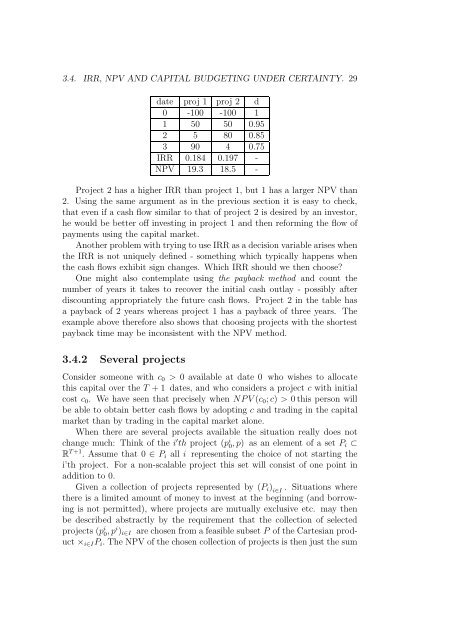Lecture Notes for Finance 1 (and More).
Lecture Notes for Finance 1 (and More).
Lecture Notes for Finance 1 (and More).
You also want an ePaper? Increase the reach of your titles
YUMPU automatically turns print PDFs into web optimized ePapers that Google loves.
3.4. IRR, NPV AND CAPITAL BUDGETING UNDER CERTAINTY. 29<br />
date proj 1 proj 2 d<br />
0 -100 -100 1<br />
1 50 50 0.95<br />
2 5 80 0.85<br />
3 90 4 0.75<br />
IRR 0.184 0.197 -<br />
NPV 19.3 18.5 -<br />
Project 2 has a higher IRR than project 1, but 1 has a larger NPV than<br />
2. Using the same argument as in the previous section it is easy to check,<br />
that even if a cash flow similar to that of project 2 is desired by an investor,<br />
he would be better off investing in project 1 <strong>and</strong> then re<strong>for</strong>ming the flow of<br />
payments using the capital market.<br />
Another problem with trying to use IRR as a decision variable arises when<br />
the IRR is not uniquely defined - something which typically happens when<br />
the cash flows exhibit sign changes. Which IRR should we then choose?<br />
One might also contemplate using the payback method <strong>and</strong> count the<br />
number of years it takes to recover the initial cash outlay - possibly after<br />
discounting appropriately the future cash flows. Project 2 in the table has<br />
a payback of 2 years whereas project 1 has a payback of three years. The<br />
example above there<strong>for</strong>e also shows that choosing projects with the shortest<br />
payback time may be inconsistent with the NPV method.<br />
3.4.2 Several projects<br />
Consider someone with c0 > 0 available at date 0 who wishes to allocate<br />
this capital over the T + 1 dates, <strong>and</strong> who considers a project c with initial<br />
cost c0. We have seen that precisely when NPV (c0; c) > 0 this person will<br />
be able to obtain better cash flows by adopting c <strong>and</strong> trading in the capital<br />
market than by trading in the capital market alone.<br />
When there are several projects available the situation really does not<br />
change much: Think of the i ′ th project (p i 0 , p) as an element of a set Pi ⊂<br />
R T+1 . Assume that 0 ∈ Pi all i representing the choice of not starting the<br />
i’th project. For a non-scalable project this set will consist of one point in<br />
addition to 0.<br />
Given a collection of projects represented by (Pi) i∈I . Situations where<br />
there is a limited amount of money to invest at the beginning (<strong>and</strong> borrowing<br />
is not permitted), where projects are mutually exclusive etc. may then<br />
be described abstractly by the requirement that the collection of selected<br />
projects (p i 0 , pi )i∈I are chosen from a feasible subset P of the Cartesian product<br />
×i∈IPi. The NPV of the chosen collection of projects is then just the sum

















